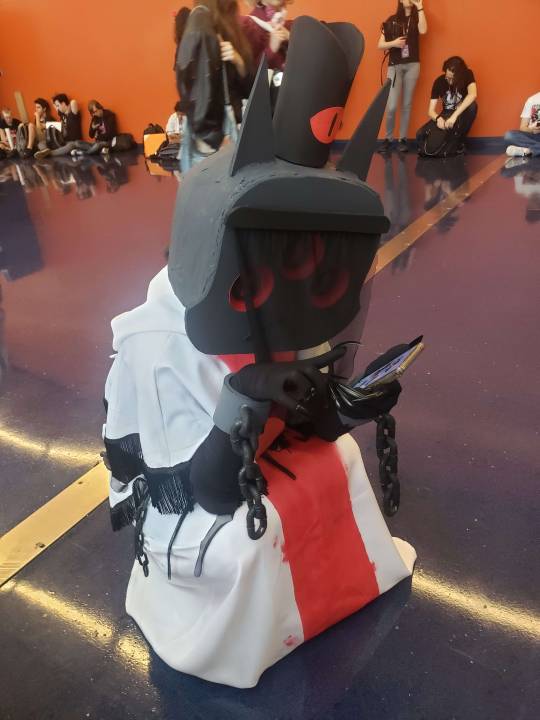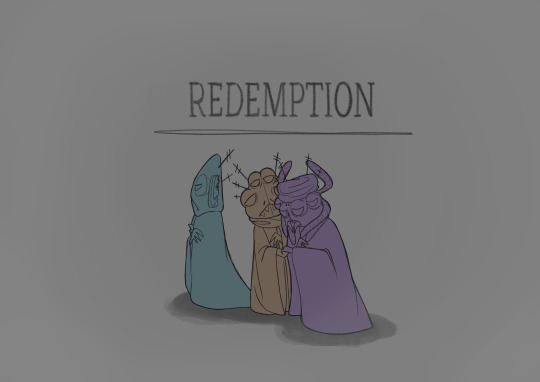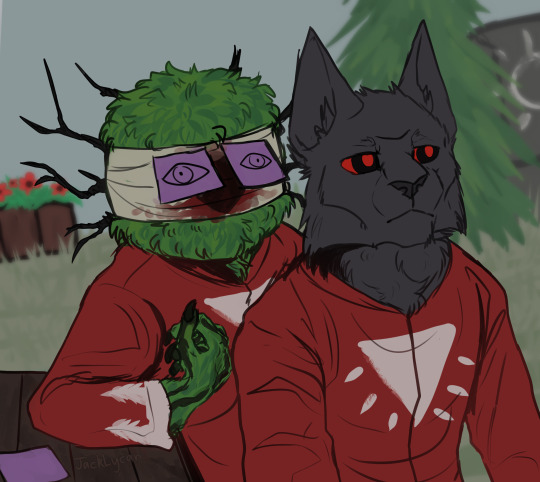【† CotL sideblog †】 【 Jacklyn ║ She/Her ║ Digital artist 】 mature content warning
Don't wanna be here? Send us removal request.
Text

Texting the lamb to see how's the cult going.
345 notes
·
View notes
Photo

Keep reading
1K notes
·
View notes
Text
Who Betrayed Who? A Cult of the Lamb analysis/theory.
The Bishops and TOWW give the Lamb conflicting accounts of the events leading up to the schism. So what actually happened? Who betrayed who? And why? I have a theory.
Let’s start with what they each say regarding the schism and the decision to imprison TOWW.
According to Shamura:
“Our brother, The One Who Waits. Back then he was known by the name Narinder. But as millennia wore on, he grew discontent with his role. He began to question. He was gluttonous in his ambition. And in my imprudence I loved him. For it, I lost my mind. For it, he lost his freedom. Can you fathom such betrayal, Lamb? Of your own turned against you? Would you like to find out?”
“The blame hangs heavy 'round my neck. I introduced him to ideas of change; for my domain is knowledge, and it is ever evolving. An organic state of being for myself, but for him... most unnatural. Death cannot flow backward. It was I who had him chained.”
According to Heket:
"It was not so long ago that we cast out the Red Crown. A mere thousand or so years. The heresy it preached could not be tolerated. Such noxious ideals... it could not be allowed. For this most damning of sins, the retribution must be slow and painful...And with greed and ambition unchecked, it drew Godly blood."
According to Kallamar:
“Please know, it was not my idea to cast out the Red Crown! The other Bishops, my siblings, the blame lies with them.”
And finally, according to The One Who Waits:
“You see me here in chains, reduced to nothing. But it has not always been thus. I was bound to this wretched place by the Bishops of the Old Faith. They betrayed me and left me to rot. Each of the four chains that bind me are guarded by one of the Bishops.”
All of them are vague about what exactly went down. The only other hint we have comes from the monument by the gates: “Here godly blood was spilled. Here Death no longer wished to wait.”
So: what actually happened?
Haro has some answers. He gives us some insight to TOWW prior to the split:
"He was unalike the rest of his kin. While others dealt with flux; chaos, famine, pestilence, war. Things in which their constancy must transpose. And yet he was the inevitable; the obstinate and irresistible. The one who waits. Truly peculiar, 'twould then seem, has appetency to invite the novel and the new, break ancient vow and primordial bond alike. Traditions stagnate and appetites augment, nonetheless. Doubt tears faith asunder."
Along with:
"Bonds of familial duty, turned instead to chains. Most voracious of appetites, curbed and contained. Most infectious of ideas cut off and cauterised before given chance to rot and spread. Cruel, verily. Alas, what other recourse was given? How does one kill Death? ... Alas. One cannot."
Haro is, as far as we know, an impartial observer to what happened. (I think based on his dialogue and seemingly intimate knowledge of the conflict, he witnessed it— but that’s a whole different post.) So his account is the closest thing we have to a neutral perspective.
From Haro we learn two key things, both of which are confirmed by Shamura and Heket’s dialogue:
1. Narinder was dissatisfied with his role amongst the Bishops. He was naturally curious and ambitious, while his domain was the only “static” one among them. In essence— he was bored, restless, and potentially feeling undervalued.
2. He was imprisoned to prevent a heresy from spreading. Which heresy? The monument and Shamura’s comments make it clear: “Here Death no longer wished to wait.” “Death cannot flow backward.” Resurrection was the unforgivable heresy.
Narinder realized that each of his siblings, whether they recognized it or not, had dual domains. Kallamar’s followers prayed for protection from pestilence, Heket’s prayed for protection from famine. They could presumably give health/fertile fields as well as inflict the opposite on heretics. Leshy's chaos could have become order, but as a "young" god, he hadn't yet reached that point. Shamura has two separate domains entirely, wisdom and war.
Narinder just had death. Static, never-changing, and irritating for someone who enjoyed the “novel and new.” I think the fact he’s a cat reinforces this. There’s even a colloquialism about it: “Curiosity killed the cat, but satisfaction brought it back.”
After serving his role, he became restless. Shamura then encouraged him to experiment with his domain, by their own admission. Perhaps they didn’t actually think Narinder would succeed, or perhaps they felt bad he was stuck in a static domain when it didn’t suit his personality. The result was catastrophic in the eyes of the Bishops: Narinder gained power over both life and death.
Why was this such a damnable heresy that it destroyed their family? A few reasons: the ✨Prophecy✨ Shamura (presumably) received, the implications of resurrection in the world of CotL, and what I think might be pre-existing divides within their family. This is where we start to delve into personal headcanons and theories, so hang in there for a second:
Narinder is the most powerful of his siblings. Full stop.
He is the hardest boss fight by far, even though he’s been chained for a millennia. You could argue that he’s empowered by the Lamb’s/cult’s devotion, but there’s a key flaw there: he imprisons the cult during the final battle, and blatantly turns against the Lamb. All devotion from the cult vanishes in that moment because the followers are very clearly pulling for the one fighting to save them: the Lamb.
So, Narinder was powerful. The most powerful. Perhaps he became the God of Death because he was instrumental in killing other gods prior to their ascension. He had a clear interest in necromancy and the world beyond, if we can assume the necromantic weapons are his. (Which they are strongly implied to be by their item descriptions.) So when they ascended, he had a fascination with death and was probably very, very good at killing— so Death initially made sense as his domain. However, Narinder was curious and creative and restless. He eventually got bored and likely began to resent his family. The most powerful of the Bishops, not capable of doing anything but waiting.
Then there was the family dynamic. Kallamar was afraid of Narinder. Heket seems antagonistic towards him. Leshy didn’t seem to have much of a relationship with him. So it’s entirely possible that resentment could have eventually led to a betrayal on Narinder’s part. But one thing held him back: Shamura.
I think Narinder was beginning to drift from his family, but turned to his eldest sibling because he still had great love for them. Shamura encouraged him to experiment, which was ultimately successful— one can presume he was intensely proud of discovering resurrection. He saw it as his crowning achievement and his way of finally leveling the scales between the five of them.
His siblings saw it differently. In the world of CotL, willing and unwilling sacrifices directly feed a god's power. Resurrection, perhaps in their minds, cheapened or weakened this power. Or, if we go with the theory that Narinder was the objective strongest, resurrection made him so powerful it scared them. If he can essentially grant eternal life to his followers, what’s to stop him from usurping our worship entirely? What's to stop a god of life and death from doing away with the others?
I think the prophecy was Shamura’s attempt to calm Heket, Kallamar, and Leshy’s fears regarding the discovery. Perhaps they had a way of divining the future— and received the aforementioned ✨Prophecy✨.
In turn, it convinced Shamura that the only way to preserve the majority of their family would be to get rid of Narinder. Haro’s dialogue strongly implies they discussed outright killing him, but realized given his domain it would be impossible. Imprisoning him was the only alternative, the only way to keep word of resurrection from spreading.
So. Who pulled the trigger first? Did Narinder actually plan to usurp his siblings, and the Bishops stopped him before he could? Or did Shamura completely blindside their brother?
I think the truth lies somewhere in the middle. I believe a betrayal was inevitable. Had the Bishops forbid resurrection and then left Narinder to his own devices, his resentment and pride probably would have eventually won out. Most of the affection they had for each other as mortals was beginning to wane, in part because they already seemed to look at him as a threat. If you treat someone like a loaded weapon, eventually they’ll decide to become one.
But I think at the true moment of the betrayal, it was Shamura.
They admit to being the one who made the final call, and also the one who encouraged him to experiment resurrection to begin with. Narinder was the closest to them in personality, and they seem to be the closest out of the five. (Some have even pointed out that TOWW chose not to watch Shamura fall to the Lamb— his dialogue as a follower implies he doesn’t know what their last moments were like, though he happily watched the others fall through the Crown.)
The most damning piece of evidence in my mind of Shamura being the true betrayer is the nature of their injury: Narinder split his favorite sibling’s skull.
The only one who outright says they loved him deeply. Because Narinder loved them, too, and in the moment of betrayal the worst of his pain and rage was directed at them. The one sibling he never thought would be capable of doing that to him. The one sibling who encouraged him to take this path, then brutally punished him for it.
As Shamura says, the two of them paid the heaviest price. The blame hangs heavy around their neck, because Shamura — the eldest and wisest of their family — set them all on the path of complete destruction.
Narinder, to me, is an excellent Lucifer allegory. Some will look at his very clear pride and say he deserved it— others will point out his true crime was challenging the existing status quo and trusting the person he loved most to listen.
211 notes
·
View notes
Text
Theory: Why Contain Death?
When you have the Resurrection Ritual and Narinder asks you to resurrect someone, something about his line after finishing the quest caught my curiosity:

Image from this post.
[ID: Narinder saying “Ha! Hahahaha! I cannot begrudge supplantation by one such as yourself. Why contain death? And with none to stand in your way. You are, after all, the last God left in the Lands of the Old Faith.”]
That’s what got my curiosity. When he said, “Why contain death?”
Then Haro told Lambert:
“He was unalike the rest of his kin. While others dealt with flux; chaos, famine, pestilence, war. Things in which their constancy must transpose. And yet he was the inevitable; the obstinate and irresistible. The one who waits.
Truly peculiar, ‘twould then seem, has appetency to invite the novel and the new, break ancient vow and primordial bond alike. Traditions stagnate and appetites augment, nonetheless. Doubt tears faith asunder.”
When Narinder got bored, he created the Resurrection ritual that broke “ancient vow and primordial bond alike.”
Why contain death? If a god could resurrect, it spells bad to the other gods. Sacrifices are no longer sacred and death as punishment is no longer consequential when pledging yourself to another god could bring them back.
As one of the characters has said, a god is nothing without their flock.
But did Narinder care? No. If that meant he would be the last God left in the Lands of the Old Faith, then so be it. If the crowns of his siblings starve and die, it will be fine because his siblings would still be alive (like what happened to Haro’s crown).
Maybe, as far as Narinder was concerned, he had thought it through with his siblings in mind.
But Shamura had to choose between Narinder and their godhoods because power isn’t something you just let go of. And so the strife between Narinder and his siblings began.
And I like to think, in a complicated way, it’s one of the reasons why Narinder would have let go of his grudge after you complete the Resurrection ritual quest. Because finally, someone understood.
1K notes
·
View notes
Text

Pomegranate
#cult of the lamb#cotl#cotl lamb#narinder#the one who waits#true devotion#narilamb#pomegranate#digital art#my art
559 notes
·
View notes
Text

Oogly boogly bitch
2K notes
·
View notes
Text

Leshy found some post-it notes
based on this image
#cult of the lamb#cotl#cotl narinder#cotl leshy#leshy#narinder#cotl the one who waits#cotl toww#cotl meme
770 notes
·
View notes
Text




my Bishop designs their accessories become trophies for the lamb after they're defeated
#cult of the lamb#cotl#bishops of the old faith#cotl leshy#cotl heket#cotl kallamar#cotl shamura#digital art#my art
434 notes
·
View notes
Text

Leshy
206 notes
·
View notes
Text

Leshy up to mischief
142 notes
·
View notes
Text

my take on Shamura love them
107 notes
·
View notes
Text

CotL-ified by sona
17 notes
·
View notes
Text

Narinder wept
#cult of the lamb#cult of the lamb fanart#cotl#the one who waits#narinder#cotl the one who waits#cotl narinder
28 notes
·
View notes
Text

Narinder attempting to dissent
743 notes
·
View notes
Text

And when he had opened the fourth seal, I heard the voice of the fourth beast say, "Come and see". And I looked, and behold a pale horse. and his name that sat on him was Death, and Hell followed with him
Book of Revelation 6:7-8
128 notes
·
View notes
Text

Forehead kisses <3
1K notes
·
View notes









